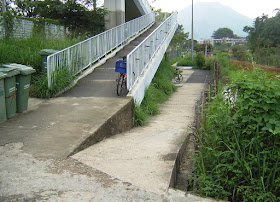It’s easy for a cyclist in Hong Kong to develop a persecution complex. For example, in Outrageous, I described how the Country Parks Authority had erected a sign warning of dire consequences (i.e. prosecution) for anyone who continued beyond the sign. Given that I’d been cycling beyond that sign for a few years prior to its erection, you can guess my response! Later in this report, I’ll be describing the latest heavy-handed attempt to regulate cycling behaviour, but first I’ve included a few examples of what cyclists here have to put up with.
When I cycle south from Fanling, I encounter the following sign on a cycle track on the northern outskirts of Taipo:
‘Cyclists dismount’? So not only are we required to give way to pedestrians crossing the cycle track—and I don’t see many of those here—we are actually expected to get off and push our bikes across this trivial hazard.
Across to the west, I took the following photo near the eastern extremity of the cycle track network that is centred on Yuen Long:
Here the position is slightly different in that the cycle track crosses a side road leading to a gate. There is nothing behind this gate, which is never open and doesn’t appear to lead anywhere, and in the scores of times that I’ve passed this way, I’ve never seen a vehicle turn off the main road into this siding. Yet we are expected to get off and push our bikes across!
On the cycle track just south of Fanling—newly opened last year—there is a side turn onto a bridge across the expressway. The cycle track and the pedestrian walkway here are completely separate, and this separation continues on the descent on the far side, but halfway down, cyclists are confronted by this:
Just to be clear, the descent continues around a 180-degree bend to the right, with the path for pedestrians and the track for cyclists continuing to be separated by railings. The only difference is that the continuation of the cycle track doesn’t yet have the distinctive coloured surface, and there are no road markings—but there is currently no work in progress to complete the surfacing, which would justify requiring cyclists to dismount.
Further south, the new cycle track crosses Tai Wo Service Road East. The next photo shows this crossing point from the south:
Of course, the situation is different here. After being comfortably segregated, cyclists are suddenly having to interact with motor traffic. In fact, the admonition to ‘use pedestrian crossing’ is common, especially at light-controlled junctions. Cyclists are expected to get off and push, but no one ever does, and no one gets a ticket either, unless they attempt to cross when the little red man is illuminated.
However, here the police have fixed a sign to the railings on the right (which you might not notice if you’re concentrating on the road ahead):
My first reaction when I saw it was to wonder whether the police had the legal authority to do this. The sign here reminded me of similar signs that were erected a short distance further south, at the bottom of a footbridge that riders on the newly opened cycle track had to use to cross the railway. This photo shows the ramp leading up to the bridge from the north in the old days, before the cycle track was built:
I can no longer remember the exact wording, but the signs warned cyclists that they faced prosecution if they rode their bikes across the bridge. You will notice immediately that this looks like a difficult feat because of the nature of the surface, and even now the majority of cyclists push their bikes across the bridge. However, someone very publicly pointed out that people had been riding their bikes across this bridge for years—Paula and I certainly had—and the police were forced to back down and remove their signs.
I believe that the police may be exceeding their authority with this latest sign, which I first noticed last autumn. Any competent cyclist should be able to negotiate this hazard safely without dismounting. First, notice that you are approaching a T-junction. You can see whether there is any traffic coming towards you as you approach; and you can see if there is anything coming from behind by exiting the cycle track between the bollards and the railings, glancing to your right before joining the road and stopping temporarily if necessary. Once on the road, you can then check for traffic coming from the left before crossing (the car in the photo is about to pass under the railway, and the road there isn’t wide enough for two cars, so in the scenario shown in the photo, you’re clear to cross if there’s nothing coming up behind you).
What I’ve just described is what I’ve always done since the cycle track appeared, but in the old days we negotiated this junction on the road. That was never a difficult thing to do, because traffic was fairly light, and nobody drove particularly fast. So will I now pay more attention to the police warning? No, I won’t! A couple of months ago, I started to look for a way of bypassing this junction altogether, and I described the results of this exploration in Detour de Force. Mind you, I take the detour now not because I want to avoid confrontation with the police. The detour is three times the distance and ten times the fun. Cycle tracks are boring.






No comments:
Post a Comment
Please leave a comment if you have time, even if you disagree with the opinions expressed in this post, although you must expect a robust defence of those opinions if you choose to challenge them. Anonymous comments may not be accepted.